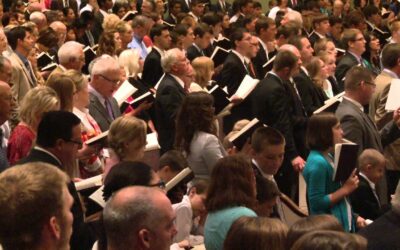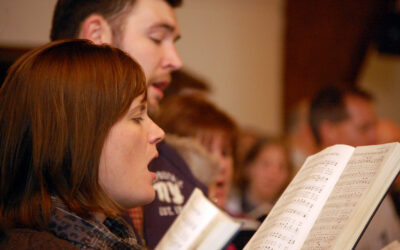Church musicians refer to “the chord” every Christmas season. This chord really has a cult following. It is referenced in social media posts and can be found on t-shirts, memes, and even coffee mugs! The chord is found in a free harmonization of the Christmas hymn “O Come, All Ye Faithful” arranged by Sir David Willcocks. Sir David was the Director of Music at King’s College, Cambridge from 1957 to 1974. While there he arranged “O Come, All Ye Faithful” for use in the annual Festival of Nine Lessons & Carols. This special evening evening service originates from the chapel of King’s College and is broadcast around the world each Christmas eve. The arrangement was subsequently published by Oxford University Press in Carols for Choirs in 1961 and has since become the standard arrangement of the carol.
WHAT IS “THE CHORD?”
So, what is “The Chord?” It is a half-diminished 7th chord. Musicians know what that is but for non-musicians that term is practically meaningless. For our purposes we’re just going to say that it’s a relatively uncommon harmony, by no means unique, but just infrequently encountered. So, when you do find it, it draws attention to itself because it sounds kind of different. If we broaden the definition just a bit, the chord would be included in a category of chords musicians call chromatic. The term “chromatic” is borrowed by musicians from the world of visual arts and it actually means “colorful.” The adjective chromatic contrasts in music with word diatonic. Now, diatonic has meant many things through the history of music but we use it today to identify notes and chords that belong to a specific scale or key. Chromatic then would be notes or chords that are foreign to a given scale or key. Hopefully we’re beginning to see that chromatic chords are special and bring harmonic interest and color to music. You could think of diatonic chords as being the nouns and verbs of language and chromatic chords being the adjectives and adverbs. Or diatonic chords being the framing of a house and chromatic chords the finishes. Chromatic chords are colorful harmonic adjuncts in music.
So “the chord” is a chromatic chord, this half-diminished 7th. But yet there’s more! Music students have to be able to identify chords when they study harmony. And, as you’d expect, they start learning the diatonic chords in their freshman year of music theory and begin full-hearted exploration of chromatic chords in their sophomore year. This chord, “the chord” is so uncommon that it wouldn’t be covered in any undergraduate music theory sequence. It’s what’s called a borrowed chord. Music students learn about borrowed chords in the fall semester of their sophomore year, but they limit their study of the genre to borrowing from our two dominant modes, what we call major and minor. But in western music there are other modes and (I’m sure you’ve been waiting for this), our chord, “the chord” is borrowed from the mixolydian mode. Musicians would call “the chord” a “iiiø7 borrowed from mixolydian.” Now, for some of you this is way too much information, but there is a point to introducing all this technical jargon and if you hang on just a second, I think you’ll see it.
THE FUNCTION OF “THE CHORD”
“The Chord” is unexpected. Its foreign to the scale used in the carol. It sounds unusual to our ears, not discordant, just different. But (and hang with me), our harmony, at least in our western music, serves a greater master, and this greater master is what we call tonality. This is a term we use to describe a philosophy, a practice, a tendency in music to make one note of the scale the most important. Almost all our music, from Bach to Rock, is founded on the idea of tonality. Our melodies have a beginning and ending note and, for the most part, those beginning and ending notes are called “tonic.” We assign the solfege syllable “do” to tonic and, just like the song says, all the other notes and chords are designed to “bring us back to do.” Harmony then has an imposed function on our music. Harmony is to start us at home base, lead us through a musical journey that may take us far away from home, but ultimately drives us right back to our starting point. We know where harmony is” supposed to go” even if we’re not professional musicians. We call that “functional harmony.” It has a greater purpose than just making our music sound colorful.
THE THEOLOGY OF “THE CHORD”
So how can we derive a theology from all this technical talk about harmony? Well, it’s all based on where “the chord” is used in the text of the carol. Sir David employed “the chord” on the word “Word” in the phrase “word of the father now in flesh appearing”. That phrase is sourced in the Gospel of John, Chapter 1 verse 14. The living word of God is Jesus. So at this point the text is making a profound declaration—the word became flesh and dwelt among us. That phrase is the climax of the entire text of the carol. God with us. But just like there was a lot of background discussion in the musical understanding of “the chord,” there’s a little background knowledge we’ve got to have in order to understand the theology of “the chord.”
God’s purpose for Man has always been for man to commune with Him. We have been wonderfully created for His pleasure so that He could be in relationship with us, his creation. But our human nature rejected that purpose. And we’re still suffering the consequences for that decision. But God promised a way for our reconciliation with him. He told his people through the Old Testament prophets that a messiah would come to champion their cause and redeem them. And even though His people were weak, fickle, self-centered, and rebellious, they longed for the promised messiah. But what they expected in a messiah was different from what God provided. They expected a might warrior to overthrow their oppressors, at that point the stinking Romans. But God’s plan wasn’t just limited to the stinking Romans. The Messiah was sent to overthrow separation from God and to restore communion between God and Man. The birth of Christ was unexpected, it was a surprise to God’s chosen people. It was a twist in the story of redemption, a “chromatic” idea in the “diatonic” messianic understanding, an unusual “borrowed chord” in the harmony of God’s grand plan. And even though “the chord” is unexpected, it fits in beautifully and fulfills its greater purpose in the function of harmony leading us through the musical journey that takes us back home. This surprise chord, this iiiø7 borrowed from mixolydian is The Word made flesh. It is our hope and our joy. Our tonal harmony, our functional harmony, teaches our ears to expect. But sometimes we employ chromatic harmony to surprise us, a unique, beautiful sound but yet, ultimately, a harmony that functions by serving a greater purpose, a harmony that reconciles us and returns us home. “Word of the Father now in flesh appearing.” “God and sinners reconciled.”
It’s our hope that as you sing these powerful words of God’s promised fulfilled this Christmas season, maybe singing Sir David’s arrangement with “the chord” that you’ll sing them will all your might proclaiming Truth and your faith.
_______________
Sacred Song Consulting exists solely to help congregations refine, revitalize, and reform traditional worship for contemporary people. We provide resources and serve as a guide to help understand and know the best practice of traditional worship. We provide the tools to prepare, plan, and implement traditional worship, the nuts-and-bolts ideas that make traditional worship work in engaging your congregation in offering their corporate praise to God. We’re here to help! You are not alone in wanting to lead your congregation in creative and transformative traditional worship. Reach out to us. Let us know how we can help!
_______________
If you’d like to order Sir David Willcocks’ arrangement of “O Come, All Ye Faithful” you’ll find it published in the two collections linked below.





Very interesting. I heard an alternate verse this morning and liked it. I could not tell from the Chalice Hymnal whether it was an original or adopted verse, I had just not seen or heard this verse before.
Thanks for elucidating the chord in Word.
The free harmonization by Willcocks is a standard across most denominations. It certainly highlights the significant text of the final verse! The Chalice Hymnal does use the Willcocks descent but unfortunately doesn’t use the free harmonization that includes “the chord.”